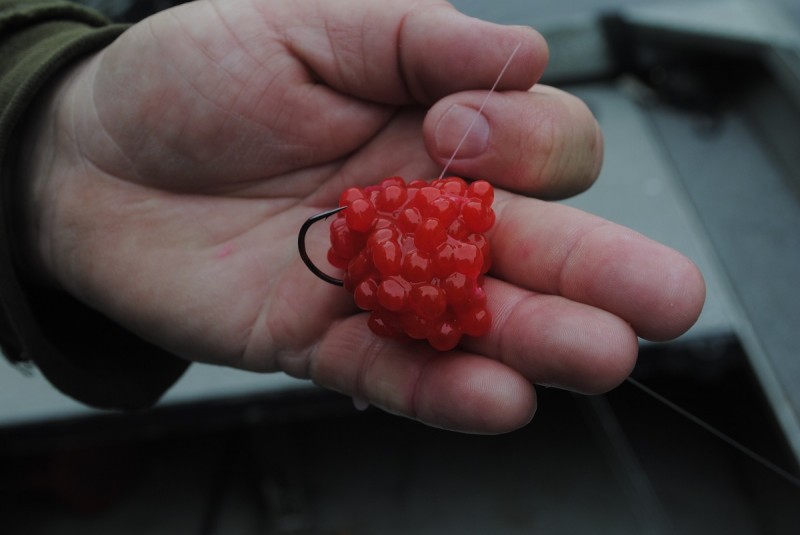Fishing “Parking Lots” and “Highways” for Michigan Fall Salmon
Bob Gwizdz 10.15.15

There are two types of places to fish for Chinooks in the river, said long-time fishing guide Denny Bouwens, as we anchored on the Muskegon River.
“There are highways and there are parking lots,” Bouwens said. “This is a parking lot.”
We were alongside a deep (12 feet) hole on an outside bend. There were several trees in the water to provide overhead cover and there was enough depth that the fish could hunker down and catch their breaths after making the upstream journey from Lake Michigan.
I tied on a big-lipped, perch-colored Junior Thunderstick and began casting, cranking it hard at first to get some depth on it, then lolly-gagging it back to the boat. On about the 10th or 15th cast, voila: a hen king (isn’t that an oxymoron?) latched onto the plug.
The fish had plenty of pep; it took line on three or four different occasions after I’d cranked it close to Bouwens’ jet sled. Once or twice, it streaked off toward tree tops or brush piles, but the 7.5-foot rod had enough backbone and the 12-pound test monofilament was strong enough that I could keep the fish out of the trash. After a few minutes—it seemed like 10 while I was fighting the fish, but was probably closer to five—Bouwens slipped the landing net into the river and I pulled the salmon into it. We were in the plus column, maybe 15 minutes after we started.
A few minutes later, I had another bump (on the same plug) but failed to connect. And by that time, Bouwens had rigged a couple of rods to fish the way he wanted: skein spawn under a bobber.
Bouwens flipped the rig out into the current and just seconds later I heard the “SWOOSH” of a hook set. Swing and a miss. Bouwens rebaited, cast, and when the bobber was in approximately the same spot it had been a couple of minutes earlier and it dove, Bouwens connected. In short order, we had our second salmon in the net.
We fished the hole hard; I never had another bump, but Bouwens connected on another in the tail out. An hour into it we had three kings in the boat.
It slowed from there; the next hole we fish failed to yield a strike. After we finished fishing it, Bouwens pulled up to the head of the hole and we drifted over it, looking to see what we could. We only saw a couple of fish.
“Not many in there,“ I said.
“That’s going to be a common refrain this year,” Bouwens said. “Not many in there. We know that. We know the king numbers are down. There are kings around, but it’s not like it used to be. You may still do double digits some days, but you’re mostly going to have to be happy with three to five or maybe even two or three.”
I’ve always been happy with that kind of day. Catching three kings between two sports in the river may seem to slow to some folks, but can you imagine reporting that to some guy from Kansas?
Kansas guy: “How’d you do?”
Michigan guy: “It was slow. Three 15-pound salmon.”
Kansas guy: [look of complete bewilderment]
Before the day was out—we fished for about five hours—we boated two more. Bouwens caught another king ( this one was sort of skinny) and I latched on to a hen that was foul-hooked. There were a pair of fish on the gravel, doing their thing, we anchored upstream of then, I floated a plug down to them and when it got it right in front of them and I closed the bail, the plug dove and both fish charged at it. The hen must have swatted it with her body as she was hooked in the back.

So we caught four.
Frankly, I was tickled as the conditions were tres difficile. The water was as clear as tap water and there was a strong wind (we both guessed it at 20 to 30 mph) that put a belly in the line like one on a WWF wrestler who’d been on a year-long beer-and-doughnuts diet. And it was overcast until noon, just before we quit. Not that that’s all bad, but it’s been my experience that when the sun’s out, there are more fish in the parking lots. On overcast days they’re on the highways.
Frankly, I‘ve always had a tough time catching them on the highways. When the kings are on the move they’ve got something other than food on their minds.
Bouwens, 46, told me that he’d caught six from the parking lots the day before (when it was sunny), all on spawn under bobbers, which is his favorite way to fish for salmon.
Bouwens was using a combination of salmon spawn and lake trout spawn. He takes his skeins, cuts them into usable-size chunks, sprinkles Pautzke Fire Cure on them, puts them in a Tupperware container and keeps them in the refrigerator until he needs them.
And he goes through a lot of spawn. Bouwens makes no more than a handful of casts before he rebaits.
“The first cast is the best cast with bait,” he said. “It puts a lot of milk in the water, a lot of scent. So don’t sit on bait. Switch it out frequently.”
You can reach Bouwens at (616) 724-0303.
For more information on Michigan fishing go to michigan.org. Click here to purchase a Michigan fishing license online.
This article was produced in partnership with Pure Michigan.

